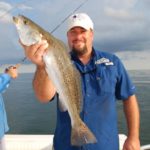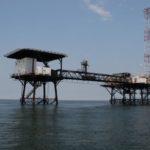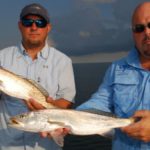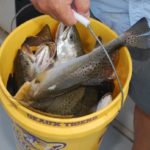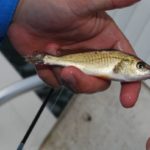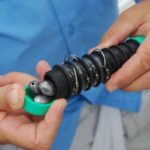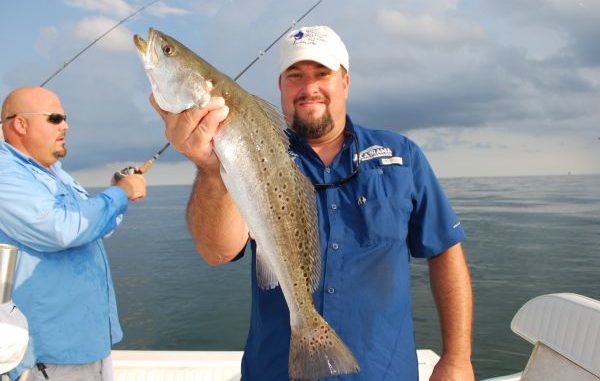
Southcentral anglers head offshore to find trout teeming around the rigs south of Vermilion Bay.
Everywhere I go, I seem to bump into Casey McLaurin, director of operations for Acadiana Outfitters, a high-end specialty outdoor retailer located on the outskirts of New Iberia. Casey loves to fish for speckled trout and he loves to duck hunt, so our talk always turns to one of the two subjects.
He is only 34 years old, young for so much responsibility, but I listen to him carefully.
Good thing.
When he mentioned a fine trout trip to me last year, he really caught my attention. They had fished offshore waters, miles outside of Marsh Island — out of sight of land the whole day. He described their catches as outa sight, as well. Out of sight and outa sight: OK — I had to go.
Actually, I had heard of this fishery before, talk of a hard-core group of speck fishermen with seaworthy boats who defy the muddy-water discharges of the Atchafalaya River into Vermilion Bay and along Marsh Island by running far offshore and fishing rigs and platforms from off of western Terrebonne to eastern Vermilion. I just never met anyone that did it before.
McLaurin told me to meet him at Shane-Gris-La, a camp on Cypremort Point owned by one of the guys I would be fishing with.
“Don’t bring anything,” he advised. “Just yourself. We should have our bait caught and will be cooking supper when you get there.”
The beautiful camp is owned by Shane Zeringue, a 40-year-old native of Breaux Bridge and a distributor for Biomet Orthopedics, a company that makes artificial knees and such.
While teammate Lane LeMaire cooked pepper-jelly glazed shrimp for appetizers and zesty creamed trout fillets, fresh tomato salad and buttered corn (see this month’s Louisiana Seafood Bible Column for the recipe), Zeringue gave me the lay of the land.
His father, he said, was always a freshwater fisherman in the Atchafalaya Basin, but he began fishing in saltwater about 20 years ago, mostly for red snapper. He kept his boat at Cypremort Point at a friend’s camp until he bought his camp, which he called “an investment in something I enjoy.”
As red snapper regulations tightened up, his attention shifted to speckled trout fishing until offshore speck fishing became his specialty.
Zeringue seems easy-going at first meeting, but he is an aggressive, competitive fisherman.
“I like to catch 100 every trip, he said.
He, Lemaire, McLaurin and Nicky Duplechien (who works in orthopedics with Zeringue), who couldn’t make the trip because of a last minute work conflict, make up “Team Bone-a-Fide” (Get it? orthopedics = bone).
Last year they entered four trout tournaments and won first place in all of them.
“I love competitive fishing,” Zeringue mumbled almost self-consciously.
The men almost exclusively use live bait — mainly croakers — which they have to catch with cast nets because of the lack of live-bait shops near Cypremort Point. But, he cautioned, there’s more to a successful trip than just throwing out live bait.
“You can’t just go there and do the same thing every trip,” Zeringue said. “What makes a trip successful is figuring them out.
“And preparation for a trout trip is half of the trip — the most important part of the trip. We tied leaders all afternoon after cast netting for 300 croakers at Marsh Island weirs. Then we bagged ice from the camp ice maker and pre-made sandwiches so that we don’t have to stop fishing to make them.”
I crawled into bed early with my tummy full of pepper-jellied shrimp and zesty trout fillets.
The next morning we left Cypremort Point in darkness, planning to make our break offshore through Southwest Pass. The bay was splattered with the running lights of working shrimp boats. But the three men didn’t notice or, if they did, they didn’t comment: They had the determined look of gladiators before combat.
Out of the pass, Zeringue turned the boat to the southwest. Before 7 a.m., we were at our first destination: Vermilion Block 51, 13 miles out of Southwest Pass.
The sun was a burning orb just peeking over the horizon and between the legs of the big yellow oil-and-gas platform.
Both Zeringue and LeMaire commented on the lack of current. LeMaire, who turned out to be an excellent educator the whole day, explained that offshore it doesn’t matter if the tide is rising or falling; it just needs to be moving for good fishing.
“Catching fish out here,” LeMaire said, “is a matter of being in the right place during a window. You will be catching fish and the boat will reposition itself indicating a tide change, and the fish will just quit.
“You may catch your 100 fish during that window and you may not.”
No one got a bite, so Zeringue pulled anchor and repositioned the boat. He explained that, most of the time, he will anchor upcurrent from the rig because it is easier to cast toward the rig out of the stern — and it allows for better bait presentation.
“But there are no hard-and-fast rules,” he grinned. “We tend to anchor where we have caught them before.”
Fifteen minutes later, they moved the boat slightly again.
The terminal rigs the men used were simple: small swivels and 2/0 or 3/0 kahle hooks separated by 2-foot-long, 20- to 30-pound-test fluorocarbon leaders.
After egg sinkers are threaded on the main lines, the leaders are tied on to the swivels.
McLaurin and Zeringue used 3/4-ounce sinkers and LeMaire used a 1-ounce weight. Their reels were spooled with 12- to 15-pound-test monofilament.
LeMaire connected first, with a 1 1/4-pound trout — not big, but OK.
The bite was slow. After 45 minutes at three spots on the rig, they pulled anchor and turned south to Vermilion 52. Here, they quickly got bites — the wrong kind.
Spanish mackerel were cutting them off cast after cast. Zeringue threatened, “I won’t put up with this long.”
Then LeMaire picked up a trout. Soon all three men were hooked up on specks. They were experts. One would net a fish one-handed for the other, all the while fighting his own fish with his other hand.
The 5-gallon fish bucket filled up quickly. None of the fish were small enough to need measurement. Some were pushing 3-pounds.
As fast as the bucket filled with trout, one or the other of the men dumped it in the ice chest.
Spanish mackerel were still plaguing the men, hitting swivels, cutting lines and mutilating baits. They caught a few, which were promptly and unceremoniously tossed back.
One bucket of trout followed the other into the huge ice chest.
The action was fast and furious. Zeringue explained what happened.
“We turned the fish on with bait, and these fish are going to cause other fish to come to see what is happening,” he said.
LeMaire said it’s imperative to actively keep the feeding frenzy going.
“We need to keep bait in the water to keep them feeding,” he said.
“Plus we like to catch our limit and get back to the camp,” grinned Zeringue.
LeMaire said getting back to the camp was their ultimate goal.
“That’s the main thing,” LeMaire. “More camp time and more time to cook.”
Zeringue said anglers had to strike when the fish were feeding.
“They will bite for an hour and then quit. We have seen that too many times,” he said.
Sure enough, the wind puffed up slightly and the boat swung on the anchor just a bit. Not another bite.
Zeringue moved the boat slightly to try to hit the bite’s sweet spot, but the angle was different.
“Now you know why we fish so fast,” Zeringue said. “Sometimes I take a different crew and they play around. With them, I catch 50; with these guys, I would have had a hundred.”
LeMaire said the difference between the crews is simple.
“They take breaks when the fish are biting,” he smirked.
McLaurin turned his baseball cap backward, quietly watched and smiled as his teammates shared more of their secrets.
First to speak again was Zeringue.
“A lot of people come out here, anchor and stay in one spot,” he said. “If you are not moving, your chances of catching trout are a lot less.”
LeMaire agreed.
“They want to wait for the fish to come to them,” he said.
Back to Zeringue: “You have to try different corners or sides of a rig.”
They repositioned the boat twice, but only picked up one more fish.
“Let’s change the scenery,” suggested Zeringue, as he put up his rod.
The next stop was South Marsh Island 233, a favorite. The rig had been removed, a heartache for any rig fishermen, but a red buoy bobbed in its place. They trio fished the site, hoping for the best.
They caught one nice trout, and that was it.
“It ain’t happening here,” Zeringue and LeMaire agreed.
They ran the boat due east to a single, towering well completion in 23 feet of water. The odd-looking well was shaped like a .30-caliber rifle shell with no surrounding superstructure. It produced a white trout, and then a small redfish.
Farther east was South Marsh Island 253, another favored spot in the men’s rig lineup.
Bam! Most of it was gone, too. The stunned men peered at four ginormous concrete blocks and a few pipes sticking out of the water.
“A lot of fish have been caught here,” murmured Zeringue quietly as he anchored.
But not this day. Zilch.
Next stop to the east was a small, single well guard within sight of Eugene Island 74.
The trout-green water at the other locations had given way to gin-clear water. They began to catch trout — and a ton of other fish — which the elite trio always referred to as “trash fish.”
“There is a lot of trash at this place,” said Zeringue resignedly, while tying on another leader, “but you got to weed through them. It can get overwhelming.”
But nice specks were mixed with the ladyfish, Spanish mackerel and occasional jack crevalle. The pleasant sound of speckled trout hitting the bucket and rattling around sounded like a $5 slot machine hitting the jackpot.
When the bite petered out, they moved to Eugene Island 74. Zeringue called it “famous.” LeMaire called it “infamous.” You can almost see them licking their chops.
Early in the season (May and June), this spot holds a lot of really nice trout, the two men explained. But not today. It was “ate up” with trash fish. Sometimes all three men were retying rigs at once.
On this day, Eugene Island 74 gave up no trout.
Last stop was Eugene Island 51, pretty much the westernmost stop on the men’s usual milk run of hotspots. The water was green, but the fishing was lean and the men called it a day.
The day’s tour, from south of Tiger Shoal to south of Atchafalaya Bay in 15 to 20 feet of water, while a few fish short of the limit, filled much of the 200-quart ice chest with speckled beauties.
Life was good.
